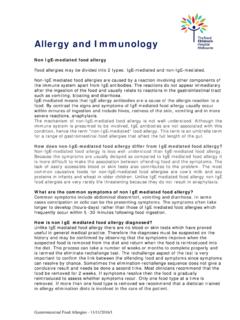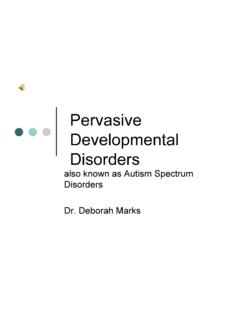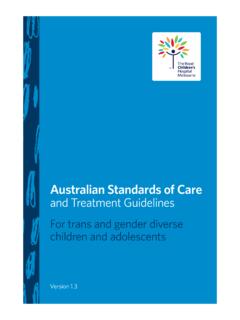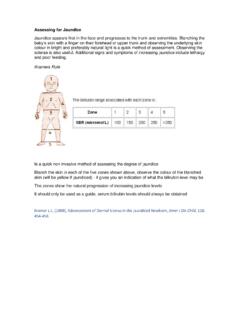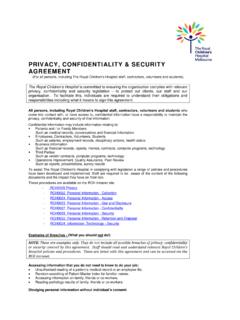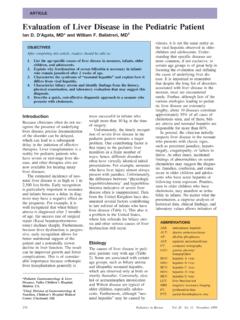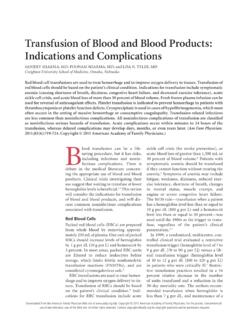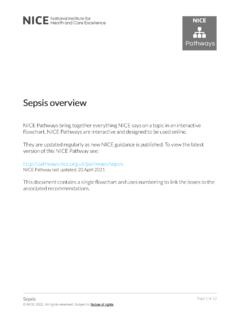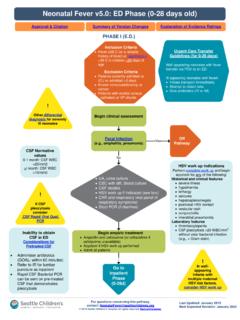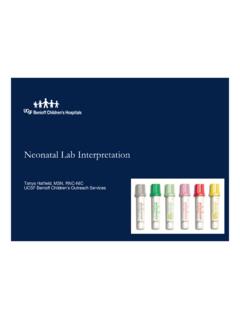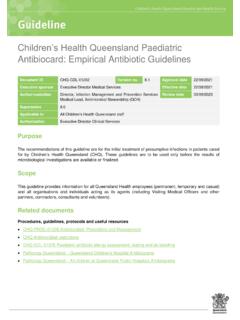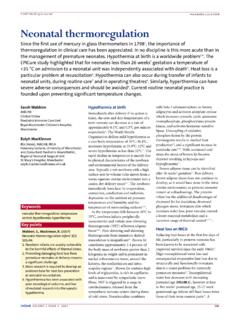Transcription of Nutrition in childhood - Royal Children's Hospital
1 FRACP lecture series Nutrition in childhood Ralf G. Heine MD FRACP. Dept. of Gastroenterology & Clinical Nutrition Royal Children's Hospital , Melbourne Importance Importance of of adequate adequate Nutrition Nutrition !Growth !Brain development !Tissue repair !Immune system !Metabolism Incidence of acute protein-energy malnutrition in hospitalised children " < 3 months 63%. " 3 - 12 months 73%. " 1 - 5 years 38%. " 6 - 12 years 41%. " 13 - 18 years 44%. J Pediatr Surg 1981;16:554. Clinical consequences of malnutrition " Loss of muscle strength : skeletal, respiratory " Increased incidence of fractures " Increase in pressure sores " Delayed wound healing " Impaired immune function " Impaired hormone function " Impaired thermoregulation " Impaired cardiovascular and gastrointestinal function " Depression/apathy " Increase in post-surgical complications Adverse Adverse effects effects of of catabolic catabolic state state # Negative nitrogen balance # Muscle wasting # Weakness # Respiratory muscle failure Fluid Fluid maintenance requirements requirements Body weight Daily fluid volume Hourly rate 0 10 kg 100 mls/kg 4 mls/kg 10 20 kg 1000 mls + (50 mls/kg)
2 40 + 2 mls/kg 20 or more 1500 mls + (20 mls/kg) 60 + 1 ml/kg Estimation Estimation of of energy energy requirements requirements # Altman-Ditmer equation ( children < 1 yr). # Schofield equation ( children > 1 yr). # Harris-Benedict equation (older children & adults). # White equation (critically ill children > 2 yrs). # Stress & activity factors # Indirect calorimetry # 90% of enteral requirements = parenteral requirements Energy Energy requirements requirements Age group [kcal/kg/d] [kJ/kg d]. Premature infants 120-150 500-630. neonates 100-120 420-500. 1 - 12 months 90-100 400-420. 1 - 6 years 75-100 320-400. 7 - 12 years 60-75 250-320.
3 12 -18 years 30-60 125-250. Adults 30-40 125-170. Protein Protein requirements requirements Age group Protein [g/kg d]. Premature infants - Infants (0 -1 yr) children 2 -13 yrs - Adolescents / adults - Protein energy malnutrition (PEM). ! Significantcause of mortality in the developing world ( children ). ! Complications: - sepsis - pneumonia - gastroenteritis Reasons for PEM in developed countries ! Chronic illness, - chronic infection (CF, HIV, TB). - malignancy - malabsorption ! Difficult social circumstances / poverty ! Mental illness / psychological problems ! Child abuse Marasmus ! Severe PEM. ! Weight loss ! Loss of muscle and subcutaneous fat !
4 Bradycardia, hypothermia (severe). ! Oedema absent Kwashiorkor ! Inadequate protein intake ! Reasonable carbohydrate and fat intake ! Oedema of lower limbs ! Muscle wasting ! Bodyweight does not represent degree of malnutrition (oedema). Failure to thrive ! Failureto thrive (FTT) is a term used to describe young children with inadequate weight gain ! No valid and reliable definition ! Protein-energy malnutrition (PEM). Micronutrient deficiencies ! Vitamins - water-soluble (B1,B6,B12,C,folate). - fat-soluble (A,D,E,K). ! Minerals and trace elements ( iron, copper, zinc, magnesium, selenium, iodine). Micronutrient deficiencies Micronutrient Clinical manifestation Vitamin A Night blindness Vitamin D Rickets Vitamin K Coagulopathy Iron Anaemia Iodine Hypothyroidism Zinc Acrodermatitis enteropathica Percentile curves !
5 Crossing of more than 2 percentile lines ! Correct for prematurity ! Weight falling below the 3rd percentile ( wasting'). ! Fall-off in linear growth after ~3 months ( stunting'). ! Head circumference not usually affected (intrauterine growth retardation or severe PEM). Length NORMAL. $. $. $ Weight $. $. $. $. $. $ $. $. $. $ $. $ $. $. $. $. $ $. $. $. Length NORMAL. $. $ Weight $. $. $. $. $. $. $ $. $. $. $. $. $. $. $. $. $. $. $. $. $. Length NORMAL. $. $. $. Weight $. $. $. $. $. $ $. $. $. $. $ $. $ $. $. $. $. $ $. $. $. $. Length FAILURE TO THRIVE. $. $. Weight $. $. $. $. $ $ $. $. $. $. $ $. $. $ $. $. $.
6 $. $ $. $. Z scores Standard deviation score %ile Z. 3rd -2. 50th 0. 97th +2 actual weight - median weight Z score =. standard deviation Z scores 2. 1 Non-FTT. (n = 14). 0. FTT. -1 (n = 4). -2. -3. 0 6 12 18 24 30 36 months Z scores for weight-for-age in 18 infants with Multiple Food Protein Intolerance Body mass index Weight [kg]. BMI =. Height [m] 2. BMI (Adults) Categories < Underweight - Ideal - Pre-obese - Obese Class I. - Obese Class II. > Obese Class III. Body composition ! Anthropometry - skin folds - mid-arm circumference ! Bioimpedence studies ! Dilution methods (total body K). Bone densitometry Nutritional assessment !
7 Estimation of energy requirement - Activity factors - Stress factors - Catch-up growth ! Assessment of dietary intake - 3-day diary ! Specific nutrient requirements Malnutrition and immunodeficiency Deterioration of nutritional Poor status Nutrition Increased Infection susceptibility to infection Micronutrients and immune function " Micronutrients that affect immune function: Zinc Vitamin A. Selenium Vitamin C. Iron Vitamin E. Copper Vitamin B6. Magnesium Folic acid " Antioxidants " Co-factors for metalloenzymes involved in nucleic acid synthesis and cell replication " Other specific direct effects on immune functions Zinc and vitamin A deficiency MORTALITY.
8 Zn Vit A. Diarrhoea %. Pneumonia % %. HIV %. Measles %. Selenium deficiency Keshan disease " Cardiomyopathy " Keshan province in China " Endemic selenium deficiency " Coxsackie B virus infection " Selection of more virulent strain of virus " ? Antioxidant deficiency Thymus and T-lymphocytes Immature bone Thymus Maturation marrow-derived of T-cells T-cell precursors in cortex Cytokines Chemokines Stem cell factor Thymic hormones Migration to Thymus Mature peripheral lymphocytes lymphatic tissues in medulla W Savino, Eur J Clin Nutr 2002; 56 (Suppl 3):S46-S49. Thymus and malnutrition " Thymic atrophy (lymphoid compartment).
9 " Occurs in protein, zinc, magnesium, iron and vitamin deficiency states in children " Severe thymic atrophy with cortical thymocyte depletion (autopsy findings). " Massive apoptosis of of CD4+CD8+ cells " Decreased thymocyte proliferation " Process reversible after nutritional rehabilitation Thymocyte Thymocyte Thymic death + proliferation = atrophy W Savino, Eur J Clin Nutr 2002; 56 (Suppl 3):S46-S49. Thymic atrophy " Thymus size in severely malnourished children " Weekly mediastinal ultrasound " Smaller thymus " More immature lymphocytes and fewer mature T-lymphocytes " Nutritional rehabilitation within 1 month " Thymic recovery after about 2 months " Thymic size as marker of immunological recovery?
10 P Chevalier et al., Sant 1996;6:201-208. Leptin " Leptin is an adipocyte-derived homone " Regulates food intake " Low leptin levels during starvation and malnutrition " Metabolic and endocrine functions " Regulates immunity, inflammation and haematopoiesis " Similarities with pro-inflammatory cytokines " Proliferative and anti-apoptotic effect on T-lymphocytes, leukaemia cells and stem cells " Affects macrophage/monocyte activation Hormonal control of thymus " Gluco-corticoid levels increased in PEM. " Leptin levels decreased in PEM. " Imbalance of glucocorticoid and leptin homoeostasis EUNUTRITION MALNUTRITION. Leptin Gluco- Gluco- Leptin corticoids corticoids Physiological thymocyte apoptosis Massive thymocyte apoptosis W Savino, Eur J Clin Nutr 2002; 56 (Suppl 3):S46-S49.



